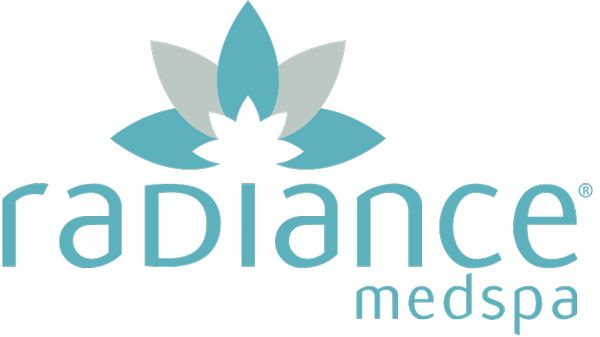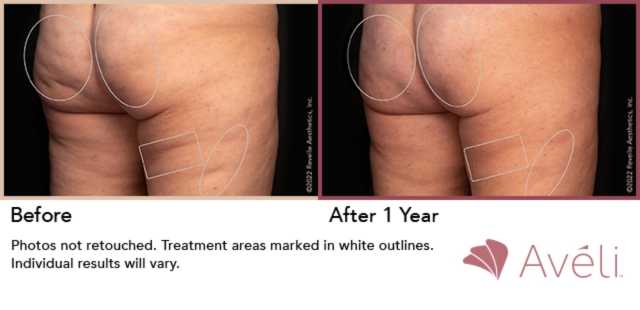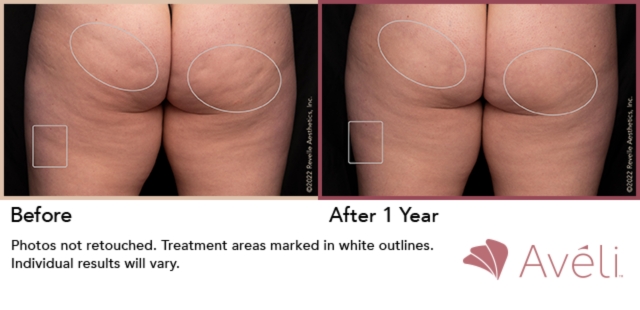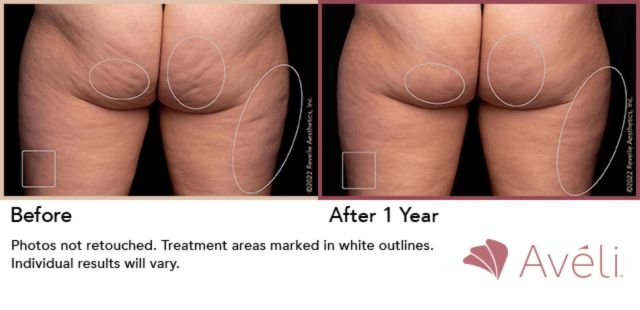 By Beth Shapouri for Allure published January 19, 2024. Read Original Article here.
By Beth Shapouri for Allure published January 19, 2024. Read Original Article here.
Fact: We’ve never met a cellulite treatment that didn’t disappoint. Could the latest one really be any different? Read on for my experience — including the pain factor, cost, recovery period, and, of course, results — and whether doctors think Avéli could be a game-changer.
I could start by saying I have cellulite, or I could simply say I am a woman. It’s estimated that 80 to 90% of the female population who has gone through puberty have this “condition” caused by fat cells pushing up against the skin while bands of connective tissue, called septa, are pulling down.
I’m a little annoyed with myself that I care at all. It feels like a failing as a feminist that I can’t embrace a perfectly benign human experience. As a journalist, who quite often writes about developments in the aesthetics industry, I have come to the conclusion that we shame women too much in general, but especially in this area. We get flack both for having cellulite and for wanting to do something about it.
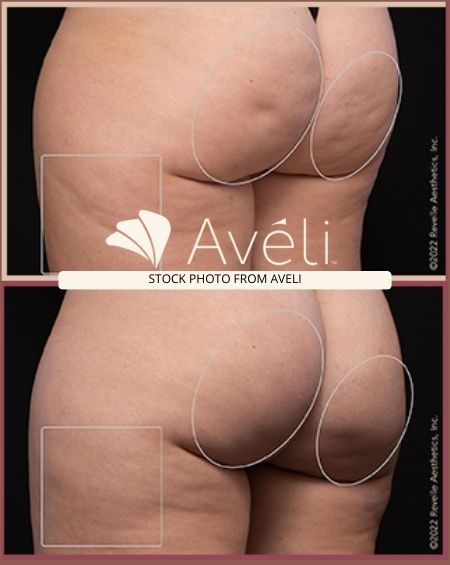
If there’s no winning, I might as well be honest with myself: I’d love to be cellulite-free. Yes, I want to fight the patriarchy; I also want smoother legs. In pursuit of the latter, I’ve tailored my workouts and tried various creams and even lymphatic massage — especially on the side of my right thigh, which had taken on a similar look to the surface of the moon — only to give up in frustration at the underwhelming results. And that makes sense as cellulite treatments in general have historically been underwhelming.
However, I can now say I have less visible cellulite than I’ve had in years, after a one-hour treatment called Avéli, a recently FDA-cleared, minimally invasive device that gets at the root of dimpling under the skin by severing the septa around the divots. (Quick refresher on what “FDA-cleared” means: A device has undergone a 510(k) submission that’s been accepted with the conclusion that it won’t cause harm and is as safe and effective as another legally marketed device. Only FDA-approved products and treatments have been rigorously tested for safety and effectiveness.) Perhaps I was feeling more experimental than usual, thanks to the various beauty treatments I had earlier in the year for my May wedding. Or perhaps my honeymoon/one-year anniversary trip to the Greek islands coming up in the spring had swimsuits on my mind. Or maybe my journalist's heart just wanted to see Avéli in action. Likely because of all three, I decided to give it a try. Never one to gatekeep, I’m here to tell you all about it two months post-treatment.
Schedule Your Consultation Today
Am I a Candidate?
What Is Avéli?
It’s a cellulite treatment you’d get at a dermatologist’s or plastic surgeon’s office, using a long, thin instrument with a light and a retractable blade. The blade pops out into a hook shape and then snaps inward, cutting septa as it retracts. The process, done under local anesthesia, takes about an hour and requires just one treatment.
It joins the septa-targeting world of technologies that aim to reduce the number of bands under the skin using microneedles (Cellfina), energy from lasers (Cellulaze), high-frequency sound waves (Resonic), or radiofrequency (VelaShape). It also succeeds the now-defunct Qwo, which used injected bacterial enzymes to dissolve the bands under the skin and was taken off the market after less than two years because it caused intense bruising and had the potential for long-lingering skin discoloration from iron-containing pigment left over from ruptured red blood cells (called hemosiderin staining).
But unlike other cellulite treatments — which may attempt to disrupt septa without breaking the skin — Avéli’s strength is that it’s incredibly precise, says David Shafer, MD, a double board-certified plastic surgeon and surgeon in New York City, who performed my treatment. “[It] allows a minimal-access incision and lighted precision to minimize tissue trauma and confirm the band has been cut,” he says. That, in theory, means it gives better results with less bruising than other options before it. (Dr. Shafer offers two devices in his practice: Avéli and NuEra, a radiofrequency device, for treating cellulite.)
Since Avéli is relatively new (it received FDA clearance in October 2021), we’re not yet sure how long the results last. In studies published in the Aesthetic Surgery Journal, effects were assessed at 90 days, and then again at 12 months. They showed that a clinically significant reduction in cellulite lasted for a year, but that’s as far as studies have gone. However, after using it on patients since late 2019, “I have yet to run into a single recurrence,” says Grant Stevens, MD, FACS, a board-certified plastic surgeon in Marina Del Rey, California, who was the original physician on the team that developed the device. (He has a financial interest in the maker, Revelle Aesthetics).
This is all noteworthy, as cellulite treatments have a reputation for not delivering. Steven Williams, MD, a board-certified plastic surgeon in Dublin, California, and president of the American Society of Plastic Surgeons (ASPS), who has seen his patients’ frustration with the results from other treatments explains, “Cellulite treatment remains one of the most challenging areas of plastic surgery in terms of successful treatments.” He says over the years he’s been let down by new offerings that promised cellulite resolution or improvement only to find, he says, “They fall short of patient and physician expectations.”
But some see Avéli as different. Laurie A Casas, MD, FACS, a board-certified plastic surgeon in Chicago, who has been performing the procedure on patients since February of 2021, now considers it to be the “gold standard” for cellulite dimpling treatment. (She used to offer Cellfina and Qwo.) It stands out from Qwo, which was “very imprecise,” she says, adding, “The skin response was unpredictable, and the skin often stayed bruised for many months.” With Avéli, Dr. Casas says, “The procedure is very satisfying because I can precisely treat the cause of the cellulite dimple — the multiple septa pulling the skin down — and verify it’s been completely treated,” she says. And Dr. Stevens calls the results “spectacular” and says using it, “I get happier every day.”
However, some doctors would like to see more evidence before going forward. “I generally remain in the camp of wait-and-see when it comes to new technologies in the space,” says Dr. Williams, who does not have any devices for cellulite in his practice, but does do subcision (a method for breaking connective tissue bands under the skin using a cannula with a razor end) and fat grafting for cellulite. He’d like to know what happens over time with the scar tissue of cut septa, for example, which he says can sometimes pull at the skin in a similar way to the band that was there previously “and result in the patient having very similar amounts of cellulite.”
Melissa Doft, MD, a board-certified plastic surgeon in New York City, who currently offers microneedling with radiofrequency as an option to help with cellulite in her office, has similar thoughts about giving it more time. She points out that in the three-month study, “only 74 patients were treated in nine different [areas], which allows for diverse variability.” She explains, “I would be interested in better understanding the long-term benefits, or when a secondary treatment may be needed.” (Dr. Doft does not have any cellulite devices in her office and has never had them because, she says, “I had never been impressed by the long-term results.”)
Who is a good candidate for Avéli?
Because of the way Avéli works, it’s best for folks who have dimpled cellulite rather than areas of rolling or wavy fat, which is caused by fat pockets rather than bands of septa interacting with fat. Beyond that, Dr. Stevens recommends it for patients who are not obese and have tight skin, as skin laxity can sometimes be mistaken for cellulite. While there’s no official age cut-off for the procedure (Dr. Shafer says candidates are determined on a case-by-case basis), it’s important to note that Avéli was tested on women 21 to 55 years old. This could help explain why Dr. Casas says she’s found that patients with mild to moderate laxity are frustrated that Avéli is not a total fix for their cellulite.
Dr. Shafer assured me I was a good candidate because I had moderate cellulite with dimpling on my butt and the backs and sides of my thighs. And since I’m in my 40s, my skin is still pretty elastic. But he also made me aware that because I have some fat pockets as well, I wasn’t going to come out looking like someone Zambonied my legs, which, okay, fair.
What results can you expect from Avéli?
Noticeable ones, according to the company’s published study, which helped inform my decision to give it a try. About 80% of the 74 subjects had a significant improvement three months post-treatment (determined by three independent physicians in a blind study review of imagery of the patients). It’s worth noting that Merz (the maker of Cellfina) says it has found that Cellfina also yielded noticeable results for 37 patients five years after treatment.
The pain rating of Avéli also seemed up my alley. It was a self-reported mean of 3.8 out of 10 for the 24 hours after the procedure and the side effects were mild, like bruising and swelling. There is also a risk of some scarring around the incision sites. Because each incision is so small, though, Dr. Williams says that with similar treatments in the past, “Most of the time, these scars are minimal.” (I can’t see any scars around my incision sites.)
It’s also important to circle back to what the definition of improvement is here: For mild or shallow dimples, Dr. Shafer says they may disappear. But with deeper, more pockmark-like divots, you may see a lessening versus complete elimination. Dr. Shafer likens it to the stitches that hold down a quilt — if you sever the thread, the fabric will still hold a bit of a pucker. “There is some memory in the skin, so, while the band is divided [meaning, it’s cut], the surface may not become completely smooth,” he explains.
How much does Avéli cost?
The price of Avéli varies by provider and the overall size of your elected area(s), but you can expect to pay between $4,000 to $6,000.
What is the Avéli procedure like?
The whole thing started with me standing and Dr. Shafer circling specific areas and dimples to hit later when I was lying down. Then I went into the treatment room where I lay on my stomach with a strip of tape covering my butt crack. Several shots of a local anesthetic were injected all over my buttocks and the backs of my thighs and allowed to take effect for several minutes.
Then the procedure started, which consisted of slipping the device under my skin with a 2mm incision. It pulled at specific septa bands that were creating my dimples and cut these septa by deploying the knife which then retracted in a slicing motion accompanied by a snapping sound. Once all the bands around that incision were cut, Dr. Shafer moved to a different spot on my leg and made a new incision, for a total of six small incisions (three per leg). As promised, the entire process, start to finish, took about an hour. My two lowest incisions had one dissolvable stitch each, while the other four just got a regular ol’ bandage.
For most of the procedure, I didn’t feel anything other than tugging, much like being numbed up at the dentist’s office. But on the edges of the anesthesia, I could feel the occasional sharp pain which ranged from a little zing to something closer to the more aggressive snap of getting a Brazilian bikini wax. But it wasn’t so bad that I couldn’t distract myself. In fact, I chatted with Dr. Shafer and his team throughout the whole thing, not just about what was happening to my backside in real-time, but about our holiday plans, where we were from, and made other small talk, which, in retrospect, is a funny thing to do when you’re mooning the entire room.
What’s recovery like?
Let’s start with the pain factor. For the first three days after the procedure, I was pretty tender. Sitting wasn’t uncomfortable, but lying on my back was a challenge. Luckily, I was able to fall asleep on my stomach. As for movement, I could go on walks immediately after my treatment (which Dr. Shafer recommended to get my blood moving and speed my healing process), but real workouts with impact were on hold for a couple of weeks. Unfortunately, I can’t report whether I was able to go back to work the same day, as I accidentally took the p.m. version of my OTC pain medication when I got home and promptly fell asleep for three hours. (Oops.) The next day, I was able to put in a full day working from home and I would have been fine to get dressed and head into the office if I had one to go to.
The incisions healed within days. As for bruising and swelling, most of mine was pretty light and went away in the first couple of weeks — except for my “moon landing” right side where the worst of my cellulite is. That puffed up and bruised terribly like I had slid into home base. Dr. Shafer assured me that what I was seeing was normal: “Bruising is unpredictable and can happen with any invasive procedure.”
The discoloration lingered for a while past the tenderness, which was gone after about 14 days. I started taking arnica pills, which some research suggests may help relieve bruising and post-bruise skin staining. While Dr. Shafer said my bruising would lighten and disappear on its own over time, to help move the process along, he sent me for a quick Vbeam laser treatment to target hyperpigmentation at the three-week mark (this typically costs $800). It took a total of nine weeks for my bruises to lighten completely, which tracks with the findings of the 90-day study. (As mentioned earlier, Qwo was taken off the market in 2022 because of “the extent and variability of bruising following initial treatment as well as the potential for prolonged skin discoloration.” A quick-but-traumatizing Google search of those cases made mine look mild in comparison.)
Now I only have some small areas of hyperpigmentation around where the cuts had been made — they are about the size of the mark you’d get after a pimple heals — which I know from experience will lighten. I’m optimistic I’ve timed this just right and the marks will be totally gone before I put on a swimsuit in public in a few months. So take note: If you have plans that include thigh nudity, make sure you’ve spaced out your appointment to allow for fading if a handful of small marks will bother you.
My biggest gripe with my Avéli experience is that I had to wear a compression garment for more than a week (with Dr. Shafer’s approval, I opted for Spanx over the medical-grade type) to reduce swelling and bruising. It was uncomfortable, hurt like hell every time I had to put it on or take it off over my tender spots, and made me feel like I was being squeezed like a tube of toothpaste. After seven days, I was able to graduate to much more comfortable compression yoga pants for the next three days when I asked for permission at my first follow-up appointment.
Was Avéli worth it? (An honest review)
I’m happy with the results, which I suspect is partially because my expectations were properly managed. I’m not ready to leave beauty writing behind to become a swimsuit model, but that wasn’t my goal. Overall, there’s definitely a difference in the before-and-after pictures, particularly of my butt (which I’m not sharing, to keep my bare booty off the internet).
The amount of dimpling you start out with is definitely a consideration. For me, the dimpling on my right side was significant enough that these results would be worth the up-to-$6,000 price tag. (I didn't pay for the procedure.) If both my thighs had milder puckering, though, that number would feel high for me.
Dr. Shafer, too, was happy with the results and let me know there are other things we could do to get my thighs even smoother, like fat grafting or using dermal fillers to plump the remaining indentations. If I were seeking perfection, perhaps I would go for it, but I am stopping here. I see a marked improvement, and since I got it with very minimal downtime, that’s enough for me to do a little victory dance.
After all, I’ve gone from a moon-surface right thigh to a texture that looks more like what happens when a breeze moves over sand, which feels appropriate for this beach-bound woman. Greek islands, I’m coming for you.

